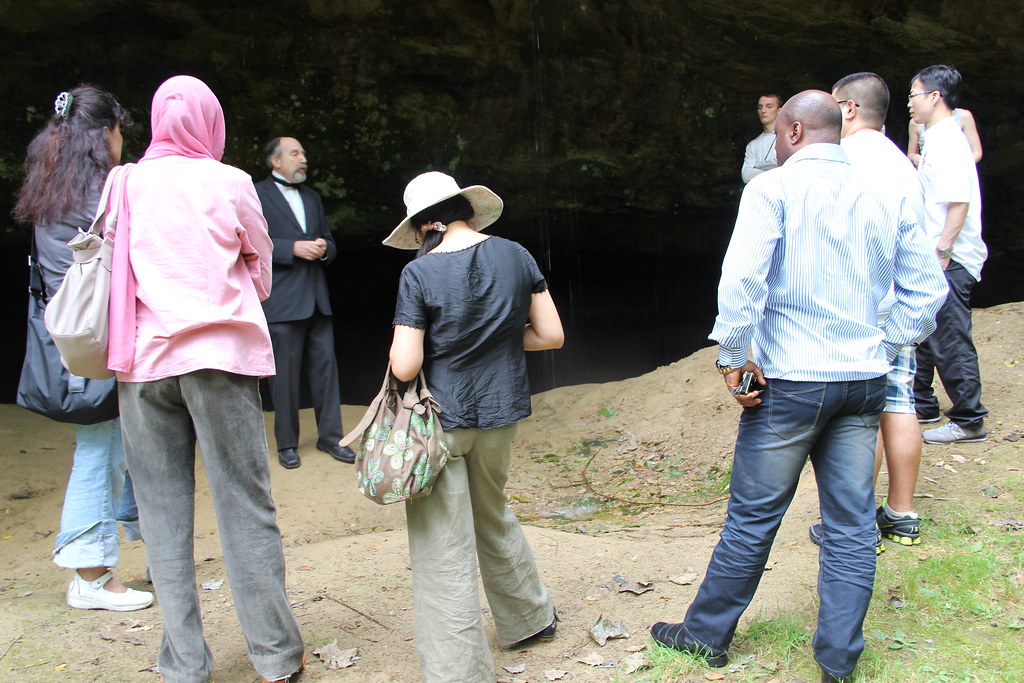By Lindsay Boyle
The 2012 SUSI scholars visited several of the Little Cities of Black Diamonds and learned about the history of the southeast Ohio region on July 15.
The SUSI summer institute — in which scholars from all over the world come to the E.W. Scripps School of Journalism at Ohio University to study journalism and media — is funded by an annual renewable grant from the U.S. Department of State’s Study of the U.S. Branch in the Office of Academic Exchange Programs.
The scholars experienced a tour provided by the Little Cities of Black Diamonds Council. It included attractions in the towns of Nelsonville, Haydenville, New Straitsville and Shawnee.
Scholar Dr. Wilberforce Dzisah said he was glad to be able to see a rural side of the U.S., because people are not typically interested in anything outside of the “glittering city life.”
“I’m really thrilled by what I’ve seen today,” he said. “It’s amazing, the rural side of the most powerful nation on earth.”
The tour began in Nelsonville’s public square, where the scholars heard a brief history of coal mining in southeastern Ohio. Nelsonville was founded in 1869, making it the oldest of the Little Cities of Black Diamonds.
The scholars were then driven through Haydenville, where they saw a round house on the National Register of Historic Places, the Haydenville United Methodist Church, which was built from five different materials, and other attractions.
Just outside of New Straitsville, the scholars observed a historic African American cemetery called Payne Cemetery. Payne Cemetery is a resting place for several African Americans from the South who had helped to create the now defunct community of Payne’s Crossing just before the Civil War.
At the cemetery, the tour guide briefly explained the sides of the Civil War, as well as concepts such as the Underground Railroad.
In New Straitsville, the scholars saw the New Straitsville United Methodist Church, Robinson’s Cave and the New Straitsville History Museum.
Robinson’s Cave is a small cave in the woods of New Straitsville where upset miners met secretly in the late 1800s. The history of Robinson’s Cave was explained through a living history method, in which Ron Luce impersonated Christopher Evans — the New Straitsville resident who led the meetings in the cave — and spoke about the happenings in the cave from Evans’ point of view.

Ron Luce, a tour guide impersonating Christopher Evans, speaks about the history of Robinson’s Cave.
The scholars learned that the meetings ultimately led to the Hocking Valley Coal Strike, as well as the formation of both local and national mine worker unions.
At the New Straitsville History Museum, the scholars first saw an outdoor mural depicting the history of the area. Inside, they observed many things that commemorated union organizing, mine fires, oil drilling and more, including old mining tools and blueprints of plans to stop the mine fires.
The final stop of the tour was in Shawnee. There, the scholars had lunch at a multi-purpose building called Tecumseh Common and then heard an overview of Sunday Creek Associates from two of its founding associates, John Winnenberg and Sandy Landis.
The SCA acts primarily as a community organizer for the southeast Ohio region. One of its goals is to aid community development projects in the area, which is one of the poorest regions in Ohio. The tours of the Little Cities of Black Diamonds, organized by the Little Cities of Black Diamonds Council, are one such project.
Winnenberg helped found the Little Cities of Black Diamonds Council in the early 1990s with the goal of preserving local history and coal town structures. He, along with Rob Dishon, helped lead the scholars’ tour.
The scholars also had some free time to observe the Tecumseh Theater, the Hocking Valley Coal Miner statue and local shops.
The Tecumseh Theater, which is the tallest building in Perry County, was opened by a fraternal organization in 1907. Though it closed in the 1950s, there is currently a movement to renovate and reopen it.

Scholars pose next to the Hocking Valley Coal Miner statue in Shawnee, Ohio.
Friday, July 20, 2012
SUSI scholars visit Little Cities of Black Diamonds
Subscribe to:
Post Comments (Atom)



No comments:
Post a Comment